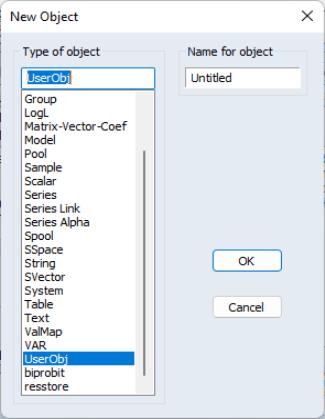Unregistered User Objects
To create a new, unregistered user object, select in the main EViews menu.
Scroll down and select , enter a name for the object in the workfile (in this example, MYOBJ), and click on . Alternately, you may enter the generic user object declaration command
userobj myobj
to create a user object named MYOBJ in the workfile.
Notice that MYOBJ has a black icon. A user object created in this fashion is empty, with no user-defined views or procedures. Double-clicking on MYOBJ opens the object and displays its contents:
As you can see, the object is empty. Clicking on the menu of the object shows only a single entry. The menu is completely empty.
An empty, unregistered userobj is not particularly interesting. You may, however, use the object as a container for EViews matrix objects (including scalars), string objects, estimation objects, and view objects (graphs, tables, spools):
• The
add and
drop procs may be used to populate the user object and the
extract proc may be employed to extract objects into the workfile.
• You may use user object data members to provide information about the contents of the object: the @hasmember(obname) member function can be used to determine whether obname exists inside the user object, while @members returns a space delimited string listing all objects in the user object.
The following program offers a simple example showing the use of these commands:
userobj myobj
myobj.add mygraph
myobj.add mytable
%list = myobj.@members
myobj.drop mygraph
myobj.extract mytable mynewtable
The first line creates a new, empty, user object called “MYOBJ”. The second and third lines copy the workfile objects “MYGRAPH” and “MYTABLE” into MYOBJ. The fourth line creates a string variable whose contents are “mygraph mytable”. The fifth line removes MYGRAPH from MYOBJ, and the final line copies MYTABLE back into the workfile under the name MYNEWTABLE.



